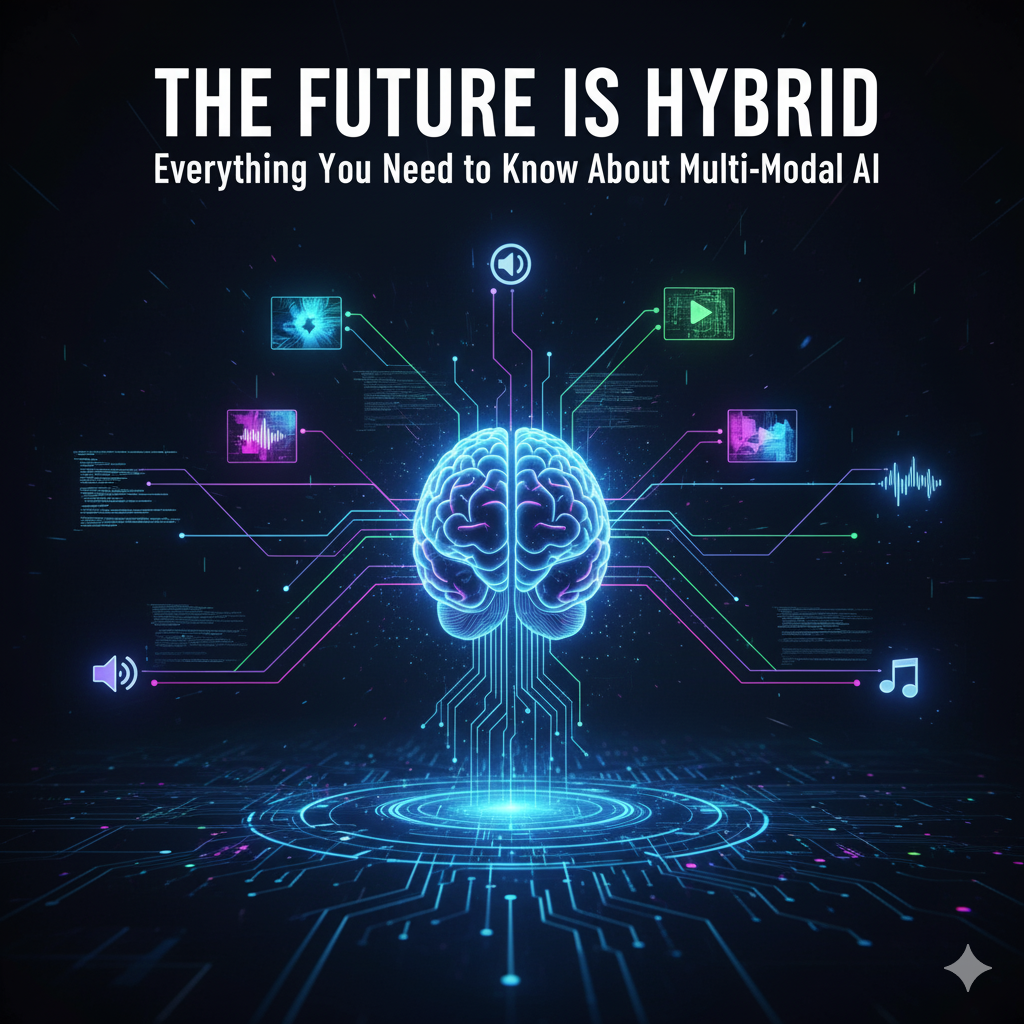AI isn’t just about words anymore.
From generating art to understanding charts or even watching videos, multi-modal AI is reshaping how we interact with technology.
Unlike text-only models like early GPT versions, multi-modal models (like GPT-4 Turbo, Gemini and Claude Sonnet) can process and combine multiple data types — text, images, audio, and even video — to create richer, more human-like understanding.
If you’re just getting started with how AI models think and respond, check out How to Understand AI Models Without the Jargon for a friendly introduction.
1. What Is Multi-Modal AI?
In simple terms, multi-modal AI means the model can understand and generate more than one type of data.
Think of it as an AI that doesn’t just read words but also sees pictures, hears sounds, and understands context across all of them.
Here’s an analogy:
- A text-only model is like a student who learns from books.
- A multi-modal model is like a student who learns from books, videos, conversations, and diagrams — connecting everything into one understanding.
Models like Gemini 2.5, GPT-4 Turbo with Vision, and Claude 3.5 are designed with this in mind — combining language understanding with visual and auditory reasoning.
To learn how model architecture enables this, read Get Better AI Results: Master the Basics of AI Architecture.
2. How Multi-Modal AI Works (Without the Jargon)
At its core, multi-modal AI merges multiple “modalities” — types of input like text, images, or sound — into a shared understanding space.
Imagine a translator hub:
- Text → Tokens
- Images → Pixels
- Audio → Frequencies
The AI converts them all into numerical data, called embeddings, which allow it to find relationships between them.
For instance, if you show it a picture of a cat and ask, “What color is this animal?”, the AI maps visual patterns to words like “gray” or “tabby.”
This shared understanding enables tasks like:
- Explaining charts or infographics
- Writing code based on screenshots
- Summarizing meetings from video or audio
- Creating visuals from written prompts
If you want to experiment with connecting tools like these, start with How to Build a Custom Chatbot with Streamlit and OpenAI.
3. Real-World Uses of Multi-Modal AI in 2025
Multi-modal AI isn’t just for research labs anymore — it’s powering tools you already use.
Here’s how it’s transforming everyday workflows:
| Use Case | Example | Impact |
|---|---|---|
| Visual Search | Perplexity + image input | Search the web using screenshots or diagrams |
| Content Creation | GPT-4 Turbo (Vision) | Generate captions, analyze layouts, and improve design |
| Learning & Education | Gemini | Reads slides, summarizes PDFs, and generates quizzes |
| Productivity | Notion AI + uploads | Extracts insights from images or files |
| Accessibility | Meta’s ImageBind | Converts sound and visuals into language for accessibility tools |
For more practical tools like these, check out Top 5 Free AI Tools You Can Start Using Today.
4. The Architecture Behind Multi-Modal AI
Multi-modal systems rely on transformer architectures — the same foundation as language models — but with specialized layers for different input types.
Simplified analogy:
- Text encoders process language
- Vision encoders analyze image patterns
- Fusion layers merge both to “cross-reference” meaning
For example:
You upload an image of a chart + ask, “Summarize this data.”
The model’s vision encoder identifies shapes and labels, while the text encoder interprets your request.
Both streams meet in the fusion layer, producing a unified, accurate response.
Want to go deeper into how these layers function?
Read AI Architecture Explained: Why It Matters (Without the Jargon).
5. Why Multi-Modal AI Matters for Creators and Businesses
Because it makes AI more human.
In the real world, we don’t communicate with just words — we use images, tone, gestures, and context. Multi-modal AI brings that dimension to digital interaction.
Here’s why it’s a game-changer:
✅ For Creators:
Generate visuals from prompts, edit videos, analyze content layouts, or brainstorm scripts — all in one interface.
✅ For Businesses:
Analyze customer feedback, automate reporting from graphs or dashboards, and create data-driven presentations with minimal input.
✅ For Developers:
Integrate text + vision APIs into your own tools using frameworks like LangChain Agents.
✅ For Students & Researchers:
Summarize lecture slides, interpret images, and generate structured notes from multiple sources.
6. The Future: Multi-Modality + Reasoning
The next evolution? Reasoning-driven multi-modality.
Soon, we’ll have AI agents that can:
- Watch videos and summarize patterns over time
- Build product mockups from sketches
- Analyze visual data for business trends
This shift will make AI not just responsive — but intuitive.
If you’re curious how this connects to agentic systems, explore Beginners Guide to AI Agents: Smarter, Faster, More Useful.
Conclusion: The Age of Unified Intelligence
Multi-modal AI is the bridge between how humans perceive the world and how machines understand it.
By merging text, vision, and sound, it’s redefining creativity, learning, and productivity.
We’re entering a world where you don’t just tell AI what you want — you can show it.
And that’s the real power of next-generation intelligence.



